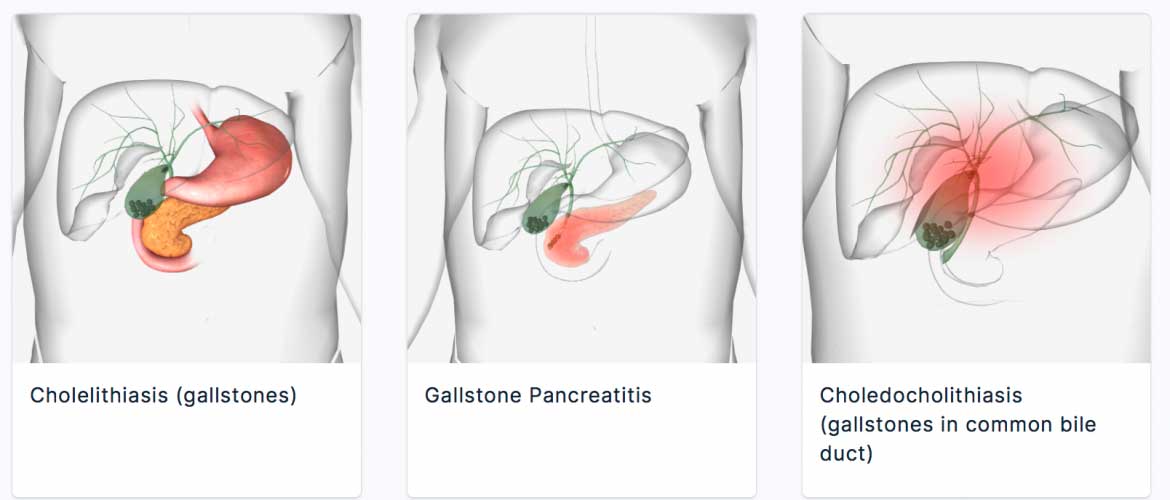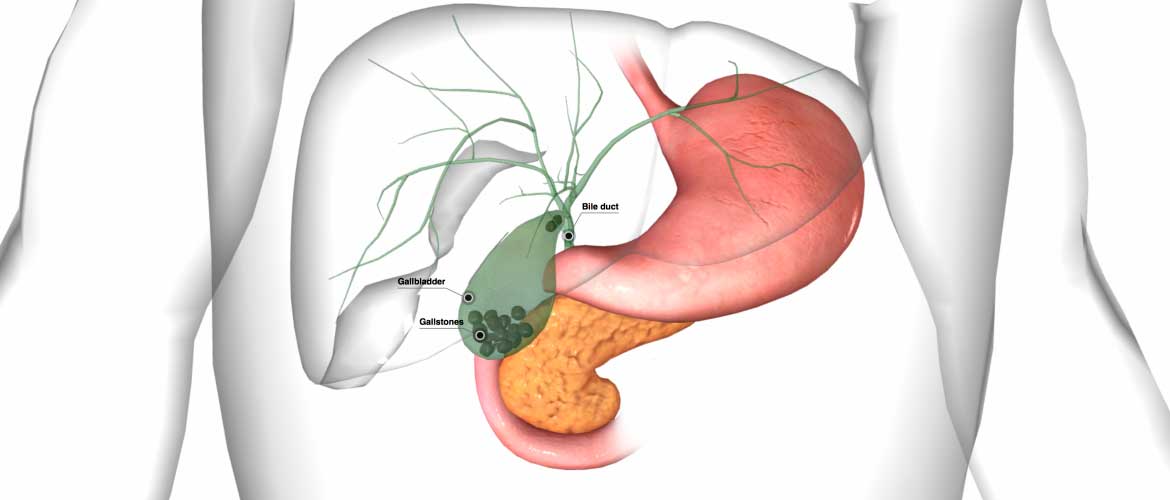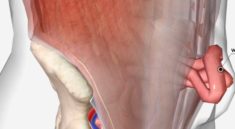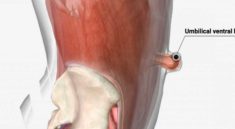

INFORMATION
Gallstones are hard, pebble-like pieces of material, usually made of cholesterol or bilirubin, that form in your gallbladder. Gallstones can range in size from a grain of sand to a golf ball. The gallbladder can make one large gallstone, hundreds of tiny stones, or both small and large stones.
When gallstones block the bile ducts of your biliary tract, the gallstones can cause sudden pain in your upper right abdomen. This pain is called a gallbladder attack, or biliary colic. If your symptoms continue and they’re left untreated, gallstones can cause serious complications.
What are the complications of gallstones?
Complications of gallstones can include:
- inflammation of the gallbladder
- severe damage to or infection of the gallbladder, bile ducts, or liver
- gallstone pancreatitis, which is inflammation of the pancreas due to a gallstone blockage
Many people do not have symptoms of gallstones until they have complications.
If left untreated, gallstones can be deadly. Treatment for gallstones usually involves gallstone surgery
What are the symptoms of gallstones?
If gallstones block your bile ducts, bile could build up in your gallbladder, causing a gallbladder attack, sometimes called biliary colic. Gallbladder attacks usually cause pain in your upper right abdomen, sometimes lasting several hours. Gallbladder attacks often follow heavy meals and usually occur in the evening or during the night. If you’ve had one gallbladder attack, more attacks will likely follow.
Gallbladder attacks usually stop when gallstones move and no longer block the bile ducts. However, if any of your bile ducts stay blocked for more than a few hours, you may develop gallstone complications. Gallstones that do not block your bile ducts do not cause symptoms.
See a doctor right away if you are having these symptoms during or after a gallbladder attack:
- pain in your abdomen lasting several hours
- nausea and vomiting
- fever—even a low-grade fever—or chills
- yellowish color of your skin or whites of your eyes called jaundice
- tea-colored urine and light-colored stools
These symptoms may be signs of a serious infection or inflammation of the gallbladder, liver, or pancreas. Gallstone symptoms may be similar to symptoms of other conditions, such as appendicitis, ulcers, pancreatitis, and gastroesophageal reflux disease, all of which should be treated by a doctor as soon as possible.
Gallstone complications can occur if your bile ducts stay blocked. Left untreated, blockages of the bile ducts or pancreatic duct can be fatal.
How do doctors diagnose gallstones?
The usual treatment for gallstones is surgery to remove the gallbladder.
Before your operation Evaluation usually includes blood work, a urinalysis, and abdominal ultrasound.
Surgeons perform two types of cholecystectomy:
- Laparoscopic cholecystectomy. Almost all surgeons perform cholecystectomies with laparoscopy. Surgeons perform many laparoscopic cholecystectomies on an outpatient basis, meaning you may be able to go home the same day. You will probably be able to return to normal physical activity in about a week.
- Open cholecystectomy. A surgeon performs an open cholecystectomy when your gallbladder is severely inflamed, infected, or scarred from other operations. Your doctor may perform a cholecystectomy if problems occur during laparoscopic cholecystectomy. After the surgery, you may need to stay in the hospital for up to a week. You will probably be able to return to normal physical activity after about a month.
Benefits
Gallbladder removal will relieve pain, treat an infection.
Possible risks of not having an operation
The possibility of continued pain, worsening symptoms, infection or bursting of the gallbladder, serious illness, and possibly death.
Risks
Bile leak, bile duct injury, bleeding, infection of the abdominal cavity (peritonitis), fever, liver injury, infection, numbness, raised scars, hernia at the incision, anesthesia complications, puncture of the intestine, and death.
Your recovery
If you do not have complications, you usually will go home the same day after a laparoscopic procedure or in 1 to 2 days after an open procedure.
If general anesthesia is given or if you are taking narcotic pain medication, it may cause you to feel different for 2 or 3 days, have difficulty with memory, or feel more fatigued. You should not drive, drink alcohol, or make any big decisions for at least 2 days.
Call your surgeon if you have severe pain, stomach cramping, chills, a high fever (over 101°F or 38.3°C), odor or increased drainage from your incision, your skin turns yellow, no bowel movements for three days, or vomiting and the inability to keep fluids down
Nutrition
- When you wake up from the anesthesia, you will be able to drink small amounts of liquid. If you do not feel sick, you can begin eating regular foods.
- Continue to drink about 8 to 10 glasses of water per day.
- Eat a high-fiber diet so you don’t strain while having a bowel movement.
Advertisement
- Go easy on the fat. Avoid high-fat foods, fried and greasy foods, and fatty sauces and gravies for at least a week after surgery. …
- Increase the fiber in your diet. This can help normalize bowel movements. …
- Eat smaller, more frequent meals. This may ensure a better mix with available bile.
How long after gallbladder surgery will I feel better?
It’ll usually take around 2 weeks to return to your normal activities. After open surgery, you’ll usually have to stay in the hospital for 3 to 5 days, and your recovery time will be longer. It can take around 6 to 8 weeks to return to your normal activities.
Can you walk after gallbladder surgery?
Walking boosts blood flow and helps prevent pneumonia and constipation. For about 2 to 4 weeks, avoid lifting anything that would make you strain. … For laparoscopic surgery, most people can go back to work or their normal routine in 1 to 2 weeks, but it may take longer.




